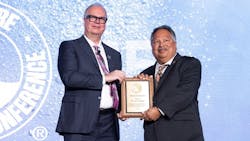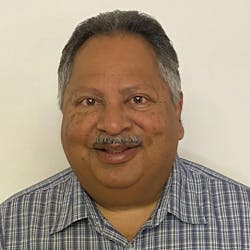OTC 2025: SOFEC CEO earns Heritage Award, shares lessons learned over 30-year career
By Ariana Hurtado, Editor-in-Chief
This year’s Offshore Technology Conference (OTC) Heritage Award was presented to Dr. Arun Duggal during the opening ceremony on Monday, May 5, in Houston, Texas.
"The Heritage Award is presented to Dr. Arun Duggal in recognition of his exemplary contributions to the offshore industry," OTC stated in a press release. "Over the 30 years he has been at SOFEC, Dr. Duggal has been a leader in the global analysis, development and the implementation of new technology for the station-keeping of floating offshore assets, focusing on turret mooring and yoke mooring systems, both permanent and disconnectable."
Dr. Duggal is SOFEC's president and CEO, a role he has held since October 2022. He has global project experience in mooring integrity and has collaborated with operators, engineers and suppliers to develop solutions for the full lifecycle of offshore moorings. Additionally, he has published more than 70 papers.
In addition, he mentors young offshore engineers by sharing his knowledge through publications, conferences and seminars.
Dr. Duggal recently chatted with Offshore and shared his experiences and lessons learned throughout his 30-year career in the offshore energy industry.
Career achievements:
Offshore: Can you share the key milestones in your career that led to the 2025 OTC Heritage Award?
Duggal: I have had the privilege of working at one company, SOFEC, for the past 30 years after being a research associate at the Offshore Technology Research Center (OTRC), Texas A&M University. SOFEC specializes in supplying specialized mooring systems, primarily for floating production facilities.
If I were to look back over my career, I think the key milestones would be:
- Completing my Ph.D. in ocean engineering at Texas A&M University under the guidance of Dr. John Niedzwecki who allowed me to explore my curiosity in wave-structure interaction. Being part of the OTRC exposed me to fascinating research in many areas of offshore engineering faced by the industry and led to many engaging discussions with industry experts;
- Being the lead engineer for global analysis and mooring for the Terra Nova FPSO (1997) was extremely challenging but fulfilling as we developed a unique disconnectable mooring system for Arctic type conditions that still operates to this day;
- Serving as the engineering manager for the mooring systems for Kizomba A and B FPSO allowed me to learn from world-class project execution teams on how to deliver a complex project on schedule and within budget;
- As a team, SOFEC developed several innovative mooring systems in the 2000s that I was proud to be a part of and helped demonstrate that teamwork led to incredible results—well beyond the sum of the parts; and
- Organizing the Mooring Integrity User Group that became an international forum for the exchange of experiences and sharing of information that was kept within companies. This has resulted in enhancing the industry’s awareness of mooring integrity issues and inspired the development of new technology, spinoff of JIPs, and improvements to design practice, installation and maintenance of these systems.
Offshore: What inspired you to specialize in mooring systems for floating offshore assets?
Duggal: In university my research focused on the dynamics of flexible cylinders in waves with a focus on TLP tendons and risers. When I joined SOFEC, I had very little knowledge of catenary mooring systems and ship hull forms, but was fascinated by the complex dynamics of these systems in the ocean environment, coupled with SOFEC’s expertise in designing and supplying these complex mooring systems. Working at a company that mentored and gave me the opportunity to learn while designing and building these systems really inspired me to specialize in this area.
Mooring challenges and solutions:
Offshore: What were some of the most challenging projects you've worked on, and how did you overcome those challenges?
Duggal: From a global analysis and mooring design perspective, I would say the projects I worked in shallow water (20-100 m) and the disconnectable turret mooring systems have been the most challenging. This is primarily due to the sensitivity of the response of the system and the challenge to design a robust system that is cost-effective and reliable.
Some examples are the Terra Nova FPSO offshore Canada, which was designed to be disconnectable for icebergs while remaining moored for the extreme significant seas of 16 m; Su Tu Den FPSO offshore Vietnam, [which is] a permanent mooring system in a typhoon region in very shallow water (45m); and the Stybarrow FPSO offshore Australia, which was designed to be disconnectable for cyclones in deepwater.
Offshore: How do you ensure mooring integrity across diverse and demanding environments?
Duggal: Mooring integrity starts from understanding the environment that drives system responses and developing a robust design of the mooring system with properly specified components. Most integrity issues result at interfaces, poor connector design, or interaction with the seabed, and can be exacerbated by corrosion. If one considers industry rules and class standards are general guidelines with minimum requirements rather than criteria that the mooring systems needs to be optimized to, you can improve the mooring integrity by designing a robust mooring system based on the specific behavior of the floating system and the environment, and industry experience from similar systems.
Offshore: Are there any different types of requirements for mooring design or materials when thinking about floating wind facilities versus floating oil and gas production facilities?
Duggal: The requirements of the mooring system to provide stationkeeping of the floating facility and ensure the envelope of excursions are within the appropriate design envelope are the same for traditional oil and gas production or floating wind systems. Due to the lower risk of environmental damage or loss of life, the extreme design criteria for wind facilities has been lowered from the typical 100-year storm to 50-year. However, most mooring integrity issues are related to fatigue and corrosion rather than extreme events, and one could argue that the fatigue capacity of the mooring system for floating wind, especially for the chain or connectors, could be lower than that of oil and gas facilities due to the lower ultimate capacity of the components. To date, most floating wind facilities use the same materials for mooring with innovation focused on peak load reduction by introducing springs or using materials like nylon.
Offshore: Are certain mooring materials (i.e., wire versus rope, nylon versus polyester, etc.) better or longer lasting?
Duggal: It depends on the application and design, and each material has pros and cons.
Today chain is used in almost all mooring systems due to its ability to allow ease of connection and adjustment, and its weight, which is important for catenary mooring applications. However, chain typically has the lowest fatigue life and is susceptible to corrosion, and if the interfaces are not properly designed, can result in failure modes that are not considered when the element is under pure tension.
Polyester rope has proven to be an extremely effective mooring material for deepwater systems but susceptible to damage if it encounters sharp edges or wire rope for example.
Nylon has been used extensively as a mooring hawser for marine terminals due to its high elasticity but is replaced quite frequently to ensure the break strength is as specified. There is a large amount of research focused on new formulations of nylon and rope structure to develop nylon ropes for permanent mooring systems, especially for floating wind facilities.
Innovations and patents:
Offshore: Could you elaborate on the innovative turret and yoke mooring systems you've developed?
Duggal: The yoke and turret mooring systems are complex interfaces between the floating facility and the seabed that provides a means of 'load-transfer' and 'fluid-transfer' between the seabed and the floating facility.
At SOFEC these systems are developed by a team of engineers from different disciplines to ensure an optimum and robust system, and I have been privileged to contribute to this development. The suite of mooring systems we have developed can be used over a wide range of water depth (20 to 3,000 m) and environmental conditions with the yoke mooring systems on the shallow water end and the various turret mooring systems covering a range from intermediate to ultradeep water. Most of the unique designs have been developed to meet the requirements of a particular development or location when conventional mooring solutions are difficult to apply.
Offshore: How do you foster a culture of innovation within SOFEC, and what role do patents play in this?
Duggal: Innovation is in the DNA of SOFEC. It existed long before I joined and hopefully will continue after I decide to retire! Engineers by nature are problem solvers looking to innovate when needed, and SOFEC has been in a unique position to have the opportunity to supply mooring systems all over the world over a wide range of conditions. Many of these mooring systems have been industry firsts and required innovative solutions and designs to meet the requirements.
At SOFEC we have a strong focus on the development of intellectual property, and [we] train and support our engineers to focus on innovation and then, if it results in unique technology, to patent it. This has resulted in SOFEC patenting several unique systems and components while utilizing the knowledge to build our systems that we supply around the world.
Industry impact and the future:
Offshore: What are the most significant changes you've witnessed in the offshore energy industry during your career?
Duggal: One of the largest changes I have seen over the past 30 years is the increase in 'engineering bureaucracy.' Today’s engineers spend significantly more time on meetings, paperwork and reporting than what was done in the past for the same design effort. A lot of this is driven by the expected work processes of today but in many cases does not seem to provide any significant improvement in the system for the cost expended. The focus on standardization and field-proven designs tend to throttle down innovation while focusing on capex reduction, which can be seen as a sign of the maturity of the technology within the industry.
Offshore: How do you envision the future of mooring systems and offshore technology?
Duggal: Mooring system design and materials will continue to evolve, and the current focus on cost reduction for mooring systems for floating wind should lead to innovations that may influence the design of mooring systems for oil and gas production facilities. Offshore technology will continue to evolve as we focus on expanding our energy resources, and the expectation is that the use of AI and data should drive efficiencies, while creating value in all areas of offshore technology in the future.
Offshore: What motivates you to continue pushing the boundaries of offshore engineering?
Duggal: As a child I was always fascinated with the ocean and that drove me to focus on engineering in the ocean. Our industry has made great strides on floating facilities, subsea infrastructure and everything in between, but there are still so many more boundaries to push through. As someone who thrives on challenge and finding solutions, our industry gives us many avenues to keep going.
Leadership and mentorship:
Offshore: How has your leadership style evolved over your 30 years with SOFEC?
Duggal: Joining a company with a very strong technical leadership team focused on mentoring us younger engineers while we were delivering mooring systems was a critical moment for me to realize that leading teams with a combination of learning, teaching and delivering results was very effective in motivating those involved.
I have benefitted from having great mentors, through my university days at A&M [and] through my career at SOFEC, who have always led by example, and that has been something I try to do as I evolved from engineering to now running the company. I feel I am still learning from people around me, and this drives me to continue to evolve while generating enthusiasm for what we do at SOFEC.
Offshore: What advice do you give to young engineers entering the offshore energy industry?
Duggal: Considering that we are in a mature industry, I have them focus on learning from the past to solve problems of the future. With an industry that has been innovating for decades and cycled through generations of talented engineers, there is a wealth of knowledge and information that is available if you just look for it. A lot of the advancement in our understanding of mooring integrity came from studying what was done in the past, and unlocking and sharing information that was kept among a few. At SOFEC, mentorship from experienced colleagues and sharing what had been done in the past have been leveraged to efficiently design new systems or solve problems that exist today.
SOFEC's Amir Izadparast, manager of new technology development, and Zhiyong Su, senior research engineer, are the session chairpersons leading the "Innovative Designs and Advanced Technologies in Riser and Umbilical Systems" technical session from 9:30 a.m. to 12 p.m. on Wednesday, May 7, in room 606 at the Offshore Technology Conference (OTC) in Houston, Texas.
About the Author
Ariana Hurtado
Editor-in-Chief
With more than a decade of copy editing, project management and journalism experience, Ariana Hurtado is a seasoned managing editor born and raised in the energy capital of the world—Houston, Texas. She currently serves as editor-in-chief of Offshore, overseeing the editorial team, its content and the brand's growth from a digital perspective.
Utilizing her editorial expertise, she manages digital media for the Offshore team. She also helps create and oversee new special industry reports and revolutionizes existing supplements, while also contributing content to Offshore's magazine, newsletters and website as a copy editor and writer.
Prior to her current role, she served as Offshore's editor and director of special reports from April 2022 to December 2024. Before joining Offshore, she served as senior managing editor of publications with Hart Energy. Prior to her nearly nine years with Hart, she worked on the copy desk as a news editor at the Houston Chronicle.
She graduated magna cum laude with a bachelor's degree in journalism from the University of Houston.


